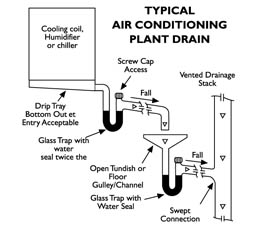|
About Legionella
The first identified outbreak of legionnaires' disease occurred among people who had attended a Pennsylvania State Convention, in 1976, respiratory examination concluded that a new bacterium now known as Legionella pneumophila was to blame.
Legionella although difficult to detect, seems to concentrate around specific areas, the most prevalent being that of stagnant water and in particular man made water systems.
After the outbreak in Stafford in April 1985, and the subsequent, 1st and 2nd reports of the committee of enquiry chaired by Sir John Badenoch, recommended CH13 paragraph 283 and 284 that drains from air conditioning units should utilise glass traps to comply with HH (Hazard) 85/6 dated 9.7.85 clause 5.
Legislation
A suitable water treatment regime must be implemented to comply with:
Health & Safety at Work Act 1974 sections 2,3 and 4, risks from legionella, inparticular the Control of Substances hazardous to Health Regulations 1988 (COSHH). Health & Safety Doc HS(G)70 'The control of legionellosis'.
Health & Safety Approved Code of Practice 'The prevention or control of legionellosis'.
Avoidance of Materials
As specified in Health & Safety recommendations HS(G)70 paragraph 43, every attempt should be made to avoid the use of materials that harbour bacteria and other micro-organism, or provide nutrients for microbiological growth, these include:-
1. Some rubbers
2. Jointing compounds and mastics
3. Wooden packing & certain plastics
And other materials as specified by the Water Research Centre (Water fittings & materials directory).
Prevention
SGL – Scientific Glass Laboratories Ltd Condensate Traps were specifically designed for the prevention / control of legionella type diseases, they are now installed in a wide range of buildings throughout the world, and have a proven track record second to none.
Inspection of the traps e.g. seal depths can be easily monitored due to the transparency of glass, dosing points allow for filling / cleaning.
|
A Typical Set-up of a Plant Drain |
 |
|
|
The self-cleaning nature of these traps helps prevent colonisation of sediments such as rust, scale, sludge and algae from providing the nutrients that support the proliferation of legionella.
Recommendations
Biocidal treatment is an essential part of all water treatment regimes, SGL – Scientific Glass Laboratories Ltd unique inert combination of borosilicate glass / PTFE (polytetraflouroethylene) sealed couplings perform safely with any temperature or biocidal fluctuations, integrity of the system is therefore assured. | 
